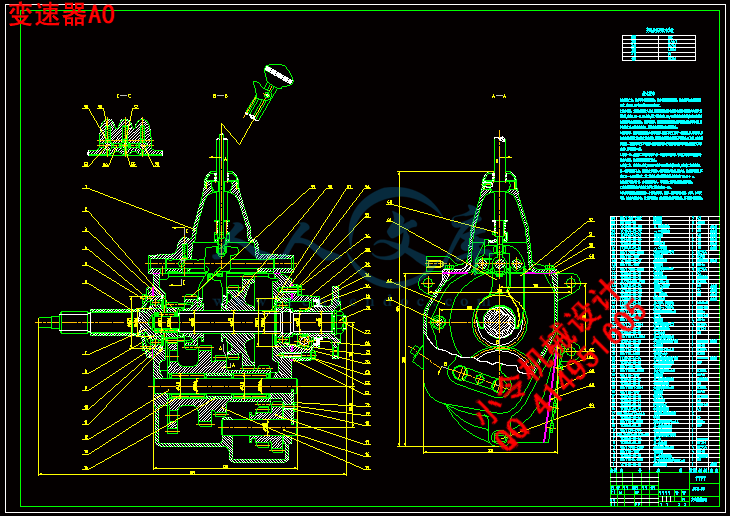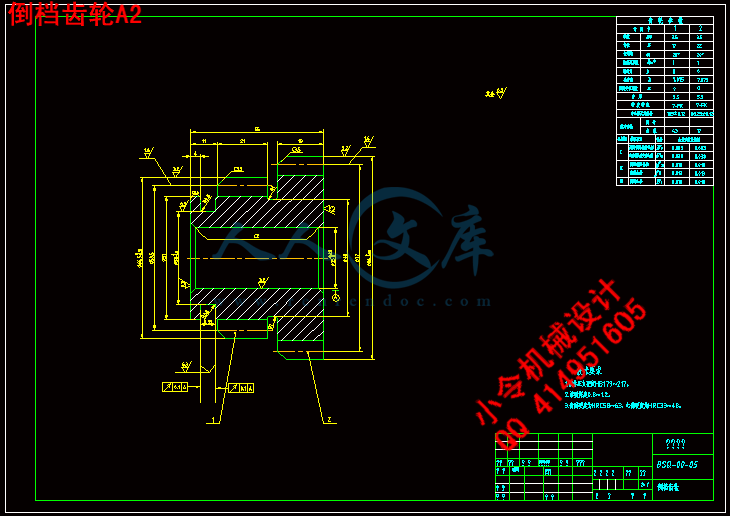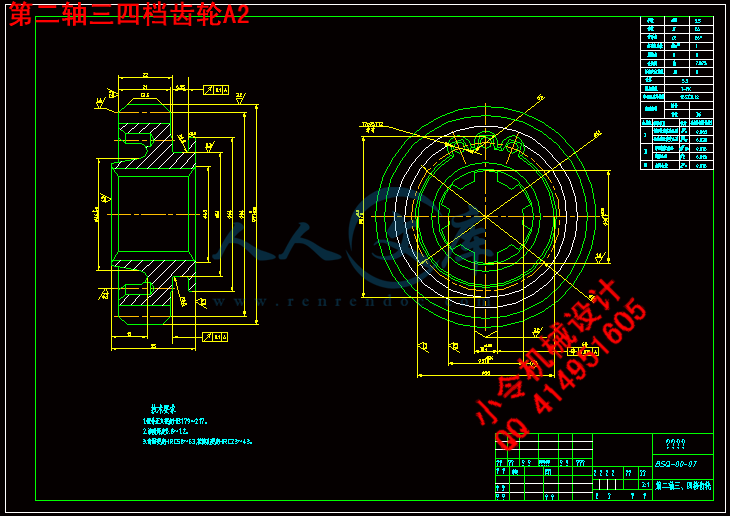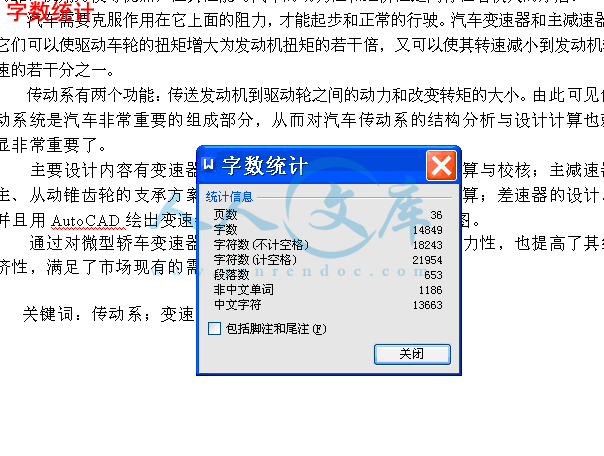【温馨提示】 购买原稿文件请充值后自助下载。
[全部文件] 那张截图中的文件为本资料所有内容,下载后即可获得。
预览截图请勿抄袭,原稿文件完整清晰,无水印,可编辑。
有疑问可以咨询QQ:414951605或1304139763
摘 要
现代汽车的动力装置几乎都是采用往复活塞式内燃机,它具有体积小、质量轻、工作可靠、使用方便等优点,但其性能与汽车的动力性和经济性之间存在着较大的矛盾。
汽车需要克服作用在它上面的阻力,才能起步和正常的行驶。汽车变速器和主减速器,它们可以使驱动车轮的扭矩增大为发动机扭矩的若干倍,又可以使其转速减小到发动机转速的若干分之一。
传动系有两个功能:传送发动机到驱动轮之间的动力和改变转矩的大小。由此可见传动系统是汽车非常重要的组成部分,从而对汽车传动系的结构分析与设计计算也就显非常重要了。
主要设计内容有变速器的布置方案与设计,齿轮的强度计算与校核;主减速器主、从动锥齿轮的支承方案选择,主减速器主要参数选择与计算;差速器的设计。并且用AutoCAD绘出变速器和差速器的装配图还有部分零件图。
通过对微型轿车变速器的设计,不仅满足了现代汽车的动力性,也提高了其经济性,满足了市场现有的需求。
关键词:传动系;变速器;主减速器;差速器
Abstract
The Reciprocating Engine are almost used as the power plant of modern motor, which is advanced in the small volume, light weight, reliability and convenience. However, there is contradiction between the performance and the dynamic and economy of the vehicle.
As to start and drive smoothly, the vehicle has to come over the resistance. The torque of the wheels could be increased as several times of the engine or be decreased one of a number of points of the engine speed by the transmission and the main reducer.
The transmission has two function transmit the engine power to the wheels and change the torque. So the transmission is one of the most important parts of the vehicle. The Analysis and design of the transmission are also vital.
The design is consisted of Layout and design of the programme of the transmission, the strength calculation and checking of the gear, the support programme of the final drive active bevel gear and driven bevel gear, the main parameters choosing and calculation of the main reducer and the Differential design. The assembly of the main reducer and the differential and the parts must be drawn with the software AUTOCAD.
According to the transmission design of the mini vehicle, the dynamic ,economy and the market of the modern vehicle are satisfied.
Key words: Power train; Transmission; Final drive; Differential
目 录
摘 要 III
Abstract III
目 录 V
1 绪论 1
1.1 本课题的研究内容和意义 1
1.2 国内外的发展概况 1
1.3本课题应达到的要求 2
2 变速器传动机构布置方案 3
2.1 传动机构布置方案分析 3
2.1.1 两轴式和中间轴式变速器 3
2.1.2 三轴式 3
2.1.3 倒挡的形式和布置方案 4
2.2 零部件布置方案分析 4
2.2.1 齿轮形式 4
2.2.2 换挡的结构形式 4
2.2.3 防止自动脱档的措施 5
2.2.4 轴承形式 5
2.3 本章小结 5
3 变速器主要参数的选择及设计计算 6
3.1 挡位数确定 6
3.2 传动比 6
3.3 中心距 8
3.4 齿轮参数 8
3.5 各档齿轮齿数的分配 9
3.6 齿轮的设计计算 11
3.7 本章小结 12
4 变速器主要结构元件的校核 13
4.1 齿轮损坏的原因及形式 13
4.2 齿轮材料的选择原则 13
4.3 轮齿强度校核 14
4.3.1 齿轮的接触强度 14
4.3.2 齿轮的接触强度 15
4.4 轴的强度校核 18
4.5 轴承的校核 22
4.5.1 输入轴轴承校核 22
4.5.2 输出轴轴承校核 23
4.6 本章小结 24
5 结论与展望 25
致 谢 26
参考文献 26
附 录 28
1 绪论
1.1 本课题的研究内容和意义
变速器的功能是在不相同的条件下,改变发动机传在驱动轮上的转矩和转速,使汽车得到不一样的牵引力以及速度,同时是发动机在最佳的工况范围内工作。此外,应保证汽车能倒退行驶和停车时使发动机和传动系保持分离。需要时还应有动力输出的功能。
随着我国千人汽车保有量的大副上升,高速公路,高级公路的不断建设,汽车正逐渐进入家庭,成为人们生活中的一部分。与此同时带来了燃料的大量需求,所以汽车的燃油经济性应给予重视。汽车的动力性、经济性能是车辆的重要性能,影响汽车的动力性、经济性能的因素很多,其中汽车的动力装置参数(发动机的参数;变速器的挡位及传动比)对上述性能的影响较大。因此对汽车变速器的研究有非常重要的社会意义和经济意义。
1.2 国内外的发展概况
手动变速器(MT:Manual Transmission)主要采用了齿轮传动的降速原理。变速器内有多组传动比不同的齿轮副,而汽车行驶时的换挡工作,也就是通过操纵机构使变速器内不同的齿轮副工作。
自动变速器(AT:Automatic Transmission)是由液力变矩器,行星齿轮和液压操纵系统组成,通过液力变矩器和齿轮组合的方式来达到变速变矩。
AMT是在传统干式离合器和手动齿轮变速器的基础上改造而成,主要改变了手动换挡操纵部分。即在MT总体结构不变的情况下改用电子控制来实现自动换挡。
无级变速器(CVT:Continuously Variable Transmission),又称为连续变速式机械变速器。金属带式无级变速器主要包括主动轮组,从动轮组,金属带和液压泵等基本部件。主要靠主动轮,从动轮和传动带来实现速比的无级变化,传动带一般用橡胶带,金属带和金属链等。
无限变速式机械无级变速器(IVT:Infinitely Variable Transmission)采用的是一种摩擦板式变速原理。IVT的核心部分由输入传动盘,输出传动盘和Variator传动盘组成。它们之间的接触点以润滑油作介质,金属之间不接触,通过改变Variator装置的角度变化而实现传动比的连续而无限的变化[1]。
汽车的发展经历了三大革命,动力革命(内燃机







 川公网安备: 51019002004831号
川公网安备: 51019002004831号